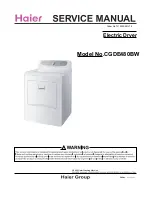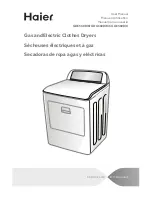
1-26
valve handle appears to be in the closed position, the microswitch is still open). If the valve is fully
closed, refer to Section 1.8.1,
TROUBLESHOOTING THE 24 VAC CIRCUIT
.
Some typical causes of ignition failure in this category include a defective sensing wire in the ignitor
assembly, a defective module, a defective ignition wire, and a defective ignitor.
Occasionally you may encounter an ignition failure situation in which all components appear to be
serviceable and the microamp reading is within specification, but the unit nevertheless goes into
ignition failure during operation. The probable cause in this case is an intermittent failure of an
ignition module. When the unit is opened up for troubleshooting, the module cools down enough to
operate correctly; however, when the unit is again closed up and placed back into service the module
heats up and fails.
PROBLEMS RELATED TO THE GAS VALVE
If the problem is not in the 24 VAC circuit, it is most likely in the gas valve, itself. Before replacing
the gas valve, refer to Section 1.8.2
TROUBLESHOOTING THE GAS VALVE
.
1.7.2 Improper Burner Function
With problems in this category, the burner ignites but exhibits abnormal characteristics such as
“popping,” dark spots on the burner ceramics, fluctuating flame intensity, and flames shooting out of
the flue.
“
Popping
” indicates delayed ignition. In this condition, the main gas valve is opening but the burner
is not immediately lighting. When ignition does take place, the excess gas “explodes” into flame,
rather than smoothly igniting.
The primary causes of popping are:
•
Incorrect or fluctuating gas pressure
•
Defective or incorrectly adjusted combustion air blower
•
Inadequate make-up air
•
Heat-damaged controller or ignition module
•
Cracked ignitor or broken ignition wire
•
Defective ignition module
•
Cracked burner tile (typically causes a very loud pop).
If popping occurs only during peak operating hours, the problem may be incorrect or fluctuating gas
pressure. Verify that the incoming gas pressure (pressure to the gas valve) is in accordance with the
appropriate CE or Non-CE Standard found in Section 2.3 of the BIPH52/55-MPH52/55 Series Gas
Fryer Installation and Operation Manual (part number 819-6087), and that the pressure remains
constant throughout all hours of usage. Refer to Section 1.4,
Checking the Burner Manifold Gas
Pressure
in this manual for the procedure for checking the pressure of gas supplied to the burner.
If popping is consistent during all hours of operation, the most likely cause is an insufficient air
supply. Check for “negative pressure” conditions in the kitchen area. If air is flowing into the
Summary of Contents for BIPH52 Series
Page 28: ...1 21 Disassembling A Frypot Full Vat Illustrated Spacers Spacer 10 2 3 4 5 6 7 8 1 11 9 ...
Page 46: ...1 39 1 11 2 Transformer Filter Boxes 1 11 2 1 MPH152 155 Transformer Filter Box ...
Page 48: ...1 41 1 11 2 3 BIPH252 255 and 452 455 Transformer Filter Box International 8051340C ...
Page 50: ...1 43 1 11 2 5 BIPH352 355 Transformer Filter Box International ...
Page 66: ...2 13 2 4 2 Drain Valves and Associated Components ...
Page 68: ...2 15 2 4 3 Rear Flush Oil Return Line Components ...
Page 72: ...2 19 2 5 2 Transformer Boxes ...
Page 76: ...2 23 2 7 Frypots and Associated Components 2 7 1 Full Vat Frypot Components ...
Page 78: ...2 25 2 7 2 Dual Vat Frypot Components ...
Page 86: ...2 33 Transformer Box Cable Assemblies 1 2 3 4 5 6 7 8 9 10 11 ...
















































